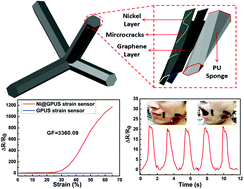A crack-based nickel@graphene-wrapped polyurethane sponge ternary hybrid obtained by electrodeposition for highly sensitive wearable strain sensors†
Abstract
Stretchable strain sensors, as crucial components in wearable intelligent devices, have become one of the recent research hotspots with promising potential in human-interactive, personal health monitoring, and flexible smartphones. Graphene-based materials have been reported for high-performance strain sensors. However, there still remain some limitations such as their high production cost and low sensitivity and stretchability. Herein, a highly stretchable and ultra-sensitive strain sensor based on nickel nanoparticles and a graphene-coated polyurethane sponge (Ni@GPUS) ternary hybrid material has been reported. Herein, Ni@GPUS was fabricated via a series of techniques including preparation of a graphene-coated polyurethane sponge, electrodeposition of nickel nanoparticles, and encapsulation by polydimethylsiloxane. The obtained sensors can be stretched up to 65% and exhibit a remarkable gauge factor of up to 3360.09. Furthermore, a fast signal response (<100 ms) and 1000 cycles of stretching and bending prove the rapid steady state response and long-term durability of the sensor, respectively. In addition, the working mechanisms of the sensor have been proposed. Moreover, the strain sensor was used as a bodily motion sensor to monitor finger bending and facial muscle tension, showing great potential in the fields of flexible, stretchable, and wearable electronics.

- This article is part of the themed collection: 2017 Journal of Materials Chemistry C HOT Papers


 Please wait while we load your content...
Please wait while we load your content...